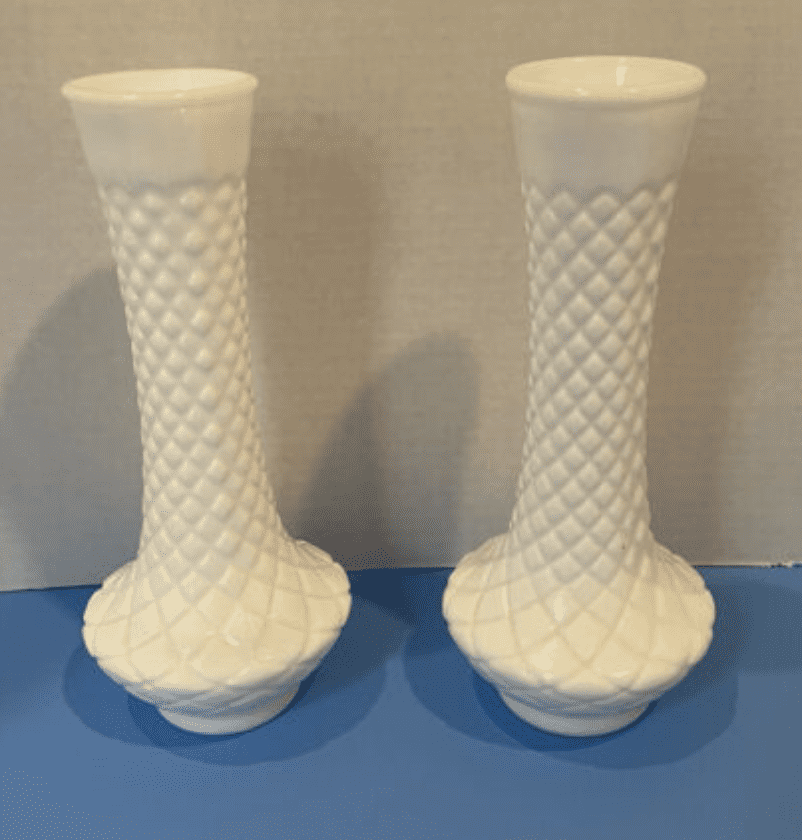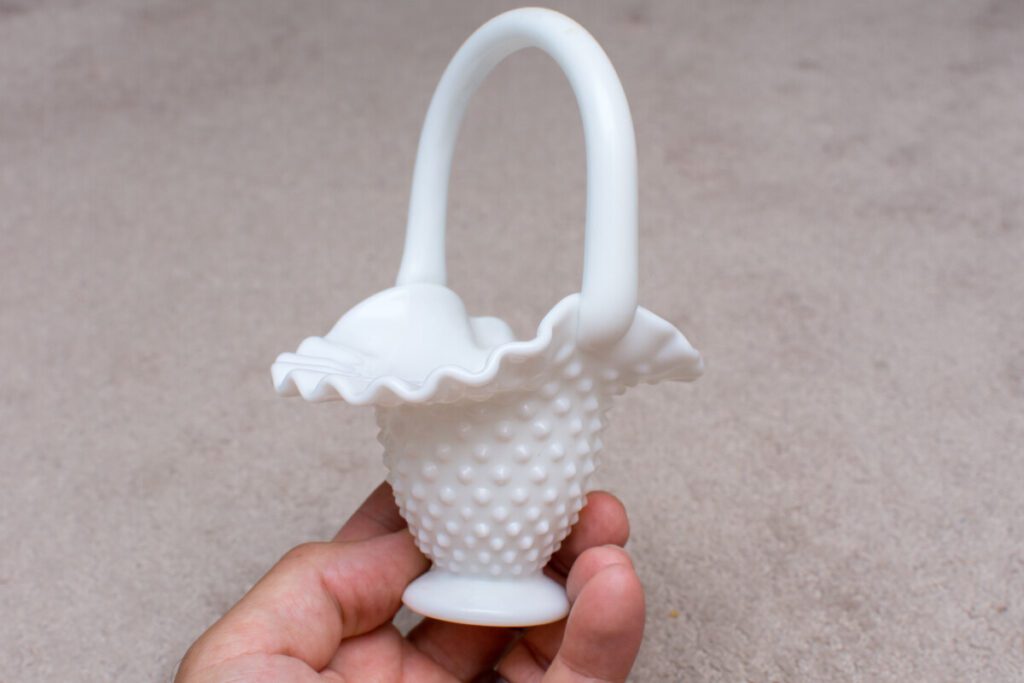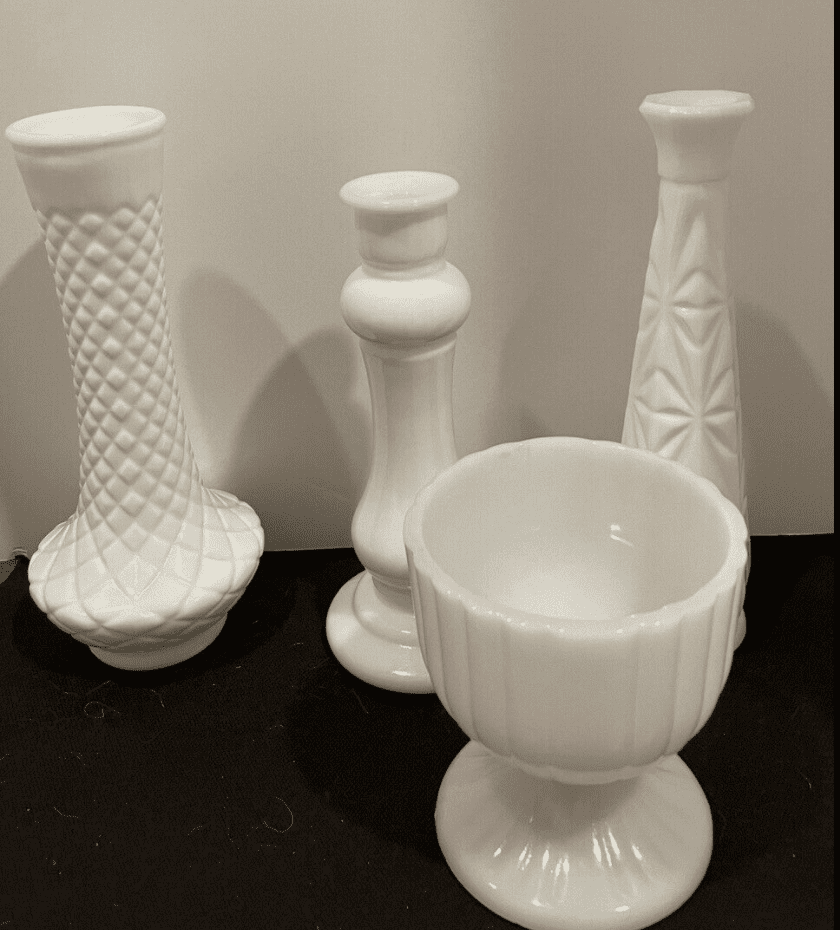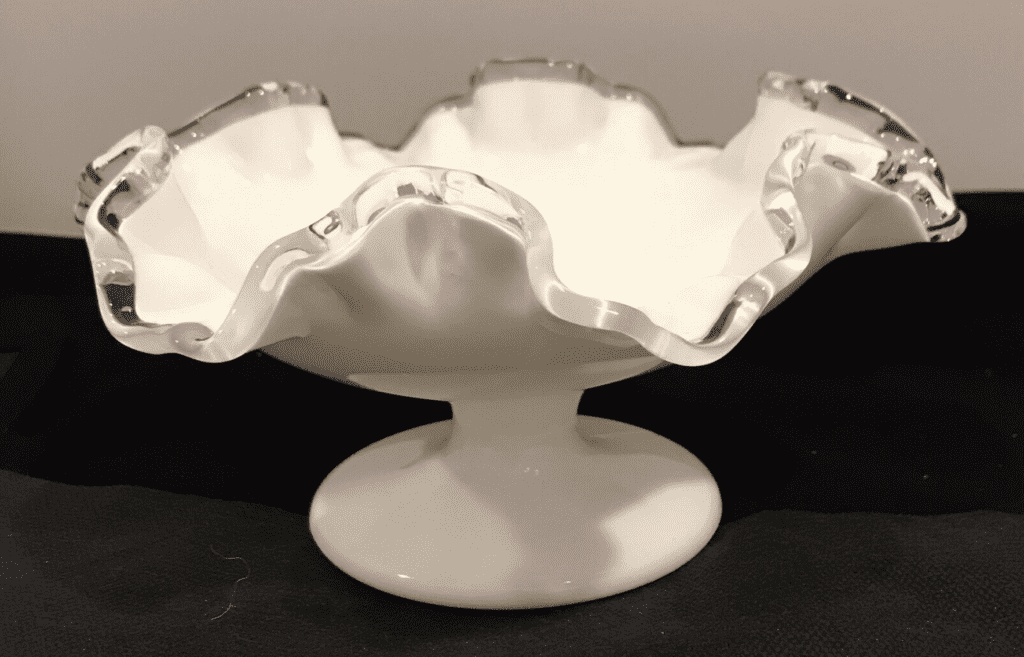Milk glass is an iconic antique that draws in many collectors. It’s a fairly inexpensive collector piece, but milk glass still holds its value.
Real milk glass from the 1800s is considered the most valuable. The design and condition of the glass also affect the value. Real milk glass is typically opaque but still allows light through when held up to a lamp. Authentic pieces generally have a manufacturer’s mark on the bottom as well.
The design and condition, combined with the authenticity of the piece determine the value, but how do you find out about your piece? Read on to learn how to determine the value of your milk glass.

Determining the value of your milk glass
There are many factors to consider when looking at the value of an antique item like milk glass. The most important things to consider are the following:
- Is it real milk glass?
- Is it authentic and antique?
- What type of piece is it?
- What ornamentation does it have?
- Does it have any unique markings?
Most milk glass pieces sell for a few dollars, while others reach a sale price of $30. However, some milk glass pieces sell at an even higher value. In general, the older the milk glass, the higher the value. The condition of the milk glass significantly impacts its value as well. Any chips, cracks, crazing, or stains could bring the value of your milk glass piece down.
While there aren’t many large sets of milk glass, there are some sets that, if complete, will sell for higher prices.
Additionally, the target audience determines a lot of the value in milk glass. Pieces with unique markings, paintings, or pictures on them tend to sell for higher prices. Some more valuable milk glass sets, and even individual pieces, have recently sold on eBay for around $500-$700.
When determining the value of your milk glass, first make sure it’s real milk glass. Then check for antique authenticity. If your milk glass was made before the 1960s, it could be very valuable. Next, search for pieces similar to yours. Take note of any special marking or features that might be mention-worthy. You can use the value of similar pieces to determine the value of your milk glass.

How to tell if it’s real milk glass
Milk glass is generally opaque white; however, some pieces may be blue, pink, yellow, green, brown, and even black. Older milk glass may appear transparent; meanwhile, milk glass from the 1950s and beyond tends to be extremely opaque and less shiny.
One way to determine if your piece is milk glass is the light test. With older milk glass, hold the piece up to the light. If an iridescent ring appears around the rim, it is milk glass. Many collectors call this trademark feature the “ring of fire.” Older milk glass will also let a little light through when held up to a lamp.
Another way to tell is by the patterns and designs. Milk glass’s main use was to create individual decorative pieces. Most pieces were handmade, and most manufacturers used the same techniques to create patterns. Some prominent patterns and designs to look out for are:
- Hobnail pattern
- Diamond pattern
- Frilled edges
- Quilted pattern
- Buttons and daisies
- Dolphin figures
- Grapes
Hobnail is the most common pattern found on milk glass. If you have a white piece with a hobnail pattern on it, you likely have real milk glass. While these are common patterns and designs, pieces with unique ornamentation will likely be more valuable. While looking for these patterns, don’t dismiss other items with unique designs, as they may still be authentic and of high value.

Is it milk, carnival, or depression glass?
Depression glass is much more transparent than milk glass. Light shines through depression glass more easily. While depression glass may be colored, it is always translucent. One unique feature of milk glass is that it is handmade. Handmade milk glass pieces feature unique patterns and styles. Meanwhile, depression glass is machine-made, limiting its design choices.
Milk glass pieces are usually more valuable than depression glass. Depression glass pieces typically sell for about $5.
Carnival glass is also generally more translucent than milk glass. Carnival glass is typically colored but has an iridescent shine to it. When held to the light, carnival glass shines an array of colors. Carnival glass is a type of pressed glass and will have different designs than handmade milk glass.
Carnival glass pieces usually sell for more than milk glass. While milk glasses sell for about $30, the starting price for carnival glass collector’s pieces is $50.
Is it milk glass, porcelain, or ceramic?
Milk glass was historically used for individual pieces or small sets, whereas porcelain or ceramic was more popular among dining china sets or other dishware sets. If you think your dining set is milk glass, chances are it’s either porcelain or ceramic.
Ceramic and porcelain are often smooth pieces without much ornamentation or patterned designs. If your pieces are smooth, they aren’t likely milk glass. Ceramics and porcelain are also more densely opaque than milk glass and won’t let any light pass through. Milk glass will usually glow or let a little light through. If the piece does glow when held up to a lamp, it’s likely milk glass.
Milk glass starts as regular glass, but opacifiers are added to the melt to create the milky opaque look. Some chemicals or ingredients that can be added as an opacifier are:
- Titanium oxide
- Zirconium oxide
- Fluorspar
- Cryolite
- Antimony
- Sulfates
- Chlorides
- Tin dioxide
- Bone ash
- Feldspar
Adding these chemicals will increase opacity and can change the color of the glass as well while still letting light pass through.
Depending on the age of the porcelain or ceramic piece, it could be worth a lot more than milk glass. For example, some porcelain pieces from the early 1900s sell for $10,000 or more on eBay.
How to tell if milk glass is authentic and antique
Older milk glass generally comes as individual pieces or in small sets. It isn’t common to find a large set of milk glass. If you’ve found a large dining set, there’s a good chance it’s not real milk glass or as old as it claims to be.
In addition to small sets and individual pieces, older milk glass is typically ornamented or adorned with delicate, precise patterns, as listed above. Most glass manufacturers didn’t make any smooth milk glass. They spent their time carefully crafting each piece with delicate patterns and designs.
Older milk glass is more likely to have the “ring of fire” when held up to light than other types or ages of glass. It is also slightly more transparent than newer milk glass, therefore, it will glow more when held up to the light.
Newer milk glass often has bumps or rough surfaces, but old milk glass has a smooth texture. Manufacturer markings can also help you age your piece.

Differences between antique and modern milk glass
Milk glass is still produced today by a few manufacturers. Modern work replicates older styles and pieces and creates new styles and designs. Not sure how old your milk glass is? Look for the patterns most common in older pieces (listed above). If the piece uses a different design, it might be newer. This makes it easy to distinguish modern milk glass from vintage milk glass.
The newer replicas can be hard to distinguish from antiques, but they may have different markings on the bottom. Check the history of your brand’s marking to verify its authenticity.
Common manufacturer stamps to look for
A great way to ensure authenticity of your milk glass piece is the manufacturer’s stamp. This is a symbol generally located on the bottom of your dish or decorative piece that states who manufactured it. This can help you determine the age of your milk glass piece. Sometimes milk glass will have a date stamped on the bottom as well.
- Dithridge & Company
- Fenton Glass Company
- Fostoria Glass Company
- Imperial Glass Company
- Kanawha Glass Co.
- L.E. Smith Glass Company
- Mosser Glass
- Thai Soojung Glass Company Limited
- Westmoreland Glass Company
The manufacturer’s mark will generally be etched or molded into the glass, but is sometimes stamped onto the glass in ink. Depending on the style of the mark, you may be able to determine the age. If you find a symbol on the bottom of your glass piece, check the brand and marking history to identify the timeframe it was used. This will aid in determining when your specific piece was made.
What glass condition and design say about value
Condition
While old milk glass is valuable, if it is in poor condition it loses value quickly. If your milk glass piece is chipped or cracked along the rim, the value will decrease. Crazing, thin shallow cracking in veins around the whole piece, will also decrease the value.
Sometimes milk glass can be stained. This can affect value as well. If the stain is not in a highly visible location, the value may not be affected as much. Other types of glass may retain their value despite chipping or other wear, but milk glass loses value with damage. It’s a less expensive collectible, so it can lose value faster with wear and tear. See also: Milk Glass Care
Design
There are a lot of common patterns milk glass can have, but some can add value more than others. Dolphin figures used as stems or on other parts of the milk glass piece are generally worth more than other patterns.
But more than a pattern, unique pieces are more valuable than a standard patterned piece. Sometimes, milk glass would be fashioned into a plate and the center of the plate would be left open for ornamentation.
For example, a plate with President William McKinley’s face painted in the center sold for $30 in an auction. While the pricing doesn’t seem great for an antique, the plate was worn, and the paint was chipping away.
Type of piece
Sometimes the type of piece can make a difference in value. Larger pieces or matching sets tend to sell for a higher price. Unique pieces also have an advantage when it comes to selling price. For example, several vintage pieces recently sold for $600 or more on eBay.
Less common items also have a greater chance of selling at a high value. Some milk glass pieces are white but have a colored rim added for flair and style. These are less common and are typically valued higher than common pieces.

Where to buy and sell milk glass
Milk glass can be purchased or sold almost anywhere. You might find (or sell) milk glass from online vintage and handmade stores, in antique shops, and at yard sales. It is also frequently passed down as an heirloom. When selling milk glass, it is important to remember where it gets sold will impact the price.
If you are looking for milk glass, you can generally find cheaper options at yard sales or on less specialized online markets, such as Facebook Marketplace, and sometimes eBay.
Once you have a value estimate for your piece, you can sell it online or go to your local antique dealer.
Before selling online, find a platform frequented by collectors. eBay is a great option for this and even offers an auction option to help drive the final price up. On eBay, people typically search for unique collectors items, so that makes it a great place to get the full value of your piece.
Another option to check is Etsy. Etsy is geared toward handmade and vintage items and will attract the audience you are looking for. Here, you will have a higher chance of finding a buyer who is willing to pay the full value of your piece.
You may also check with local antique shops. Some antique stores will buy antiques from you. Because the shop’s intent is to resell the piece, they will likely offer less than the total value, so they make a profit. While this eliminates the work required to sell a piece online, it doesn’t get as high a return.

